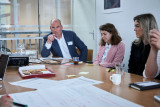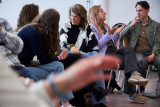When thinking about the decarbonization of cities, Local Energy Systems (LES) are often mentioned as one of the key enablers in the future. While there is agreement that LES have a role to play in the energy system of the future, what exactly is this role and how do we scale up implementation of this solution?
Cities are a major source of GHG emissions, with UN estimates suggesting that cities are responsible for ~75% of global emissions, mainly by means of transport and energy use in buildings. The decarbonization of buildings within urban areas can prove especially difficult, as space is limited, issues like grid congestion delay further electrification and there are a lot of stakeholders involved.
LES can be a solution in the decarbonisation of buildings in urban areas, like residential spaces, business parks and hybrid areas, creating positive energy districts that simultaneously reduce their impact on the grid. Preliminary LES pilot programs indicate that a LES can support decarbonization by integrating renewable generation and efficiently using energy by decreasing energy losses due to smart grids, communal energy management systems and by combining generation and use as locally as possible. We are however still in the early stages of building and growing LES around the globe, which is why we are focused on getting the right stakeholders together and learning about the requirements for scaling up such systems.
## Case & Set-up of the Session
During the latest Transition Day we hosted a work session on the topic of LES. In the past months, a number of partners in the Amsterdam Smart City network have expressed interest in the topic and would like to work together on the topic. Simultaneously the HvA, who is working on the ATELIER project with the aim to create Positive Energy Districts (PEDs), developed a framework to structurally categorize the various aspects involved in implemeting a LES. During the Demo Day, we considered two topics related to LES The first was a the framework created by the HvA, with the intention of capturing feedback and validating the approach. Secondly, we considered how we can move from an informal network around LES, to a structural coalition that can scale up the concept.
## Insights
A framework for structurally capturing aspects of a LES
Omar Shafqat from the HvA / ATELIer project presented their framework for structurally capturing and monitoring aspects of LES. The framework categorizes various aspects into policy, market, technical and social considerations (from top to bottom). Next to that, it divides these aspects on a timeline along a planning horizon from longer term (planning) to shorter term (management). The framework is shown below in this image.
In response to the framework, the participants shared some the following feedback:
- Testing the framework is necessary to validate and improve it. This implies an inventorization of LES projects and working through a few specific cases to check how the framework can be applied, and how it can benefit project managers/owners.
- The framework should also be presented and validated by other key stakeholders such as Amsterdam’s “Task Force Congestion Management”.
- Participants raised the question of who exactly will use the framework, and how? Is this intended as an instrument to be used primarily by academics, and researchers, or also by practitioners?
Forming a coalition on the advancement of LES
The second part of the work session was moderated by Joost Schouten from Royal Haskoning DHV, who led the discussion on the need for building a coalition around LES. He argued that the further development of LES requires an ecosystem approach, since multiple parties with different interests are involved, but there is no clear ‘owner’ of the problem.
A ‘coalition of the willing’ could help to advance the development of LES. A discussion in breakouts led to the following insights:
- A coalition should be formed by the community itself, but it requires a party that coordinates during the kick-off phase. A discussion emerged around whose role should be to take on the coordination phase. Some participants were of the view that this should be led by a governmental party, others thought this should be organised by a network party like Amsterdam Smart City.
- To effectively build a coalition, the involved parties need to be interdependent. To make sure that it is clear that the parties in a LES are interdependent, the parties need to state their interests in developing a LES, to determine whether there is a common goal.
- Even when these interests are not fully aligned, communication between parties can help bridge gaps. Discussion leads to understanding and empathy.
- An ambassador can be a vital enabler in the beginning of building a coalition, as a clear face and point of contact for such a group.
- There are already many other communities and coalitions working on topics related to LES, including but not limited to 02025, New Amsterdam Climate platform, TET-ORAM, TopSector Energie, among others. A key question is whether a new coalition is necessary, or whether it should be possible to join forces with an existing coalition / initiative.
## Conclusions and next steps
Many work session participants indicated support and interest to further contribute to the development of the LES project. The HvA framework was viewed as a useful tool to capture learnings from LES projects to facilitate scaling up. Additionally, the question of how to facilitate collaboration and coalition forming requires further attention. There are many parties involved in the development of LES, and they don’t always have the same interests. However, this is not an issue that any party can ‘own’ or ‘solve’ on its own. It requires an ecosystem approach, which is something that will need to be further detailed.
For now, we will simultaneously work on further building the coalition and looking for LES projects that can be used to test and further develop the framework. If you would like to know more or get involved in the project, for example by contributing you own LES to be tested by the framework itself, let me know via noor@amsterdamsmartycity.com.
This challenge was introduced in the Amsterdam Smart City network by Lennart Zwols from gemeente Amsterdam and Omar Shafqat (HvA). The session was prepared with and moderated by Joost Schouten from Royal HaskoningDHV. Do you have any questions or input for us? Contact me via noor@amsterdamsmartcity.com or leave a comment below. Would you like to know more about the LES challenge? You can find the overview of the challenge with the reports of all the sessions here.





